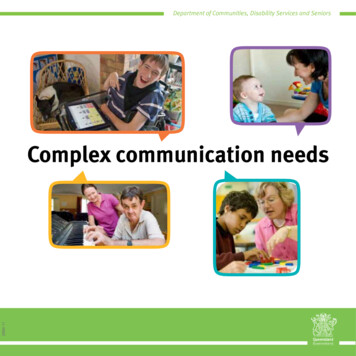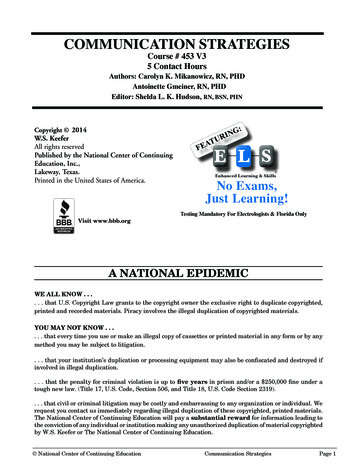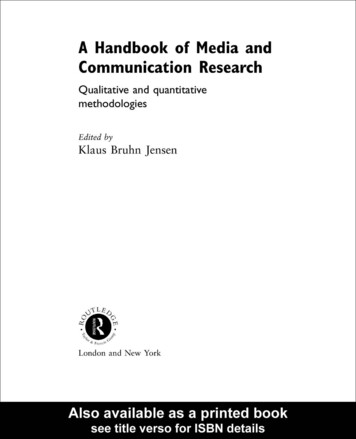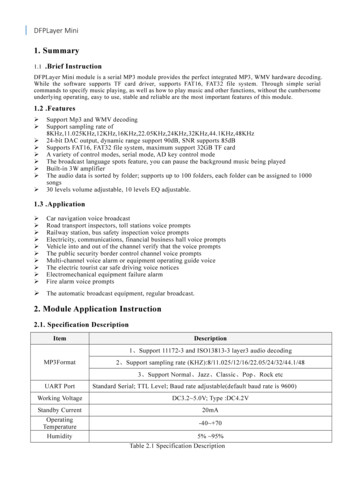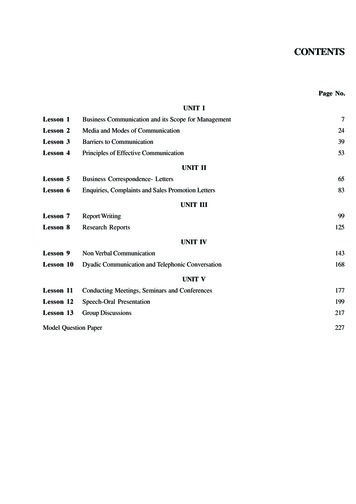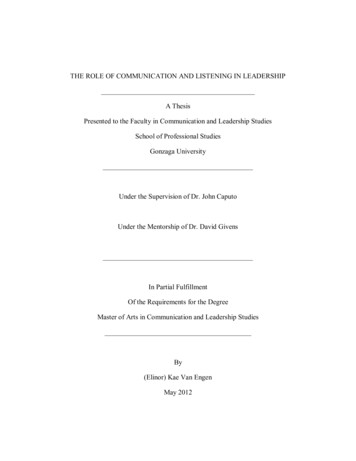
Transcription
THE ROLE OF COMMUNICATION AND LISTENING IN LEADERSHIPA ThesisPresented to the Faculty in Communication and Leadership StudiesSchool of Professional StudiesGonzaga UniversityUnder the Supervision of Dr. John CaputoUnder the Mentorship of Dr. David GivensIn Partial FulfillmentOf the Requirements for the DegreeMaster of Arts in Communication and Leadership StudiesBy(Elinor) Kae Van EngenMay 2012
AbstractIn our world today, leadership is important in many organizations. Leaders create the opportunityto develop relationships based on listening. Listening is a multidimensional construct thatrequires further integration within leadership studies. This study aimed to seek the validity offocusing on listening within the study of leadership. The research promotes the understanding ofthe verbal and nonverbal characteristics of the listening process that have the greatest ability toinfluence a person’s leadership potential, as well as examining what leadership characteristicscan influence a person’s listening. Understanding these characteristics presents evidence thatlistening deserves the recognition to be studied as an important communication skill.Specifically, the focus was to send a survey to an equal number of educational institutions andbusinesses to create a balance of education and implementation within a workforce. The surveywas sent to these organizations and then a snowball sampling occurred. Total completed surveysincluded a response rate of 97.4 percent, and respondents indicated behavioral characteristics, aswell as nonverbal responses to be important in a listening setting. Responses were compared toKouzes and Posner’s Ten Commitments of Leadership and Greenleaf’s model of ServantLeadership. Further results of this study, indicated that leadership settings incorporate certainverbal and nonverbal behaviors. This study supported that leadership is about behavior, ratherthan personality or character. Also provided are suggestions for further studies regarding thesetopics.
Table of ContentsAbstractChapter 1: IntroductionPurpose of the StudyImportance of StudyStatement of the ProblemDefinition of TermsOrganization of Remaining ChaptersChapter 2: Literature ReviewPhilosophical Assumptions and Theoretical BasisThe LiteratureRationale for StudyResearch Questions1122345671919Chapter 3: Scope and Methodology21The Scope of the StudyThe Methodology of the Study2122Chapter 4: The StudyIntroductionData AnalysisResults of the StudyDiscussionChapter 5: Summary and ConclusionsSummary of the StudyLimitations of the StudyRecommendations for Further endix: Survey44Informed ConsentSurvey Instrument4445
Chapter 1: IntroductionEveryone participates in communication on a daily basis. Communication is about peoplespeaking and listening. Listening to others, as well as understanding others is essential. It is oftensaid that listening is the first language skill one develops, and as a result all cognitive skills aredependent on the ability to listen. The Greek philosopher Epictetus may have been the firstperson to notice that humans were created with two ears, but only one tongue, so that humansmay listen twice as much as they speak (King, 2008, p. 2718). Today, we hear and use manyproverbs about this wisdom.Leadership is also about people; people communicating, developing relationships andpeople working to improve society. Leadership depends on interactions and the use ofcommunication. Since meaning is generated through communication, developing relationshipswith others and leading others requires knowledge of listening.The Problem/GoalThe concept of listening in leadership is not without many challenges. Listening is animportant behavior; however, it should also be considered a leadership quality. Both servantleadership and transformational leadership seek to earn respect and trust by developingrelationships, and relationships develop though shared dialogue. The International ListeningAssociation advocates for listening, yet theoretical research in the listening field is lackingcurrency (Janusik, 2010, p. 203). Research has focused on developing listening as a skill requiredfor effective leadership. De Pree (2004) states “a leader’s most trusted and familiar tools arecommunication skills” (p. 104). Hackman and Johnson (1994) indicate “leadership competenceis the product of communication competence” (p. 50). As a leader, listening for understanding is1
important, as well as listening for needs and desires of those served (Steil & Bommelje, 2004;Wolvin 2010a).The intent of this study is to look at listening and connect the overall success of aleader to the component of listening. In so doing, the various components of the listening processwill be understood.Importance of the StudyThis study explores the concept of listening and its relationship to effective leadership.Listening is often equated with hearing; however, this is not the case. Having the ability to heardoes not guarantee a person’s ability to listen, since hearing happens automatically (Barker &Watson, 2000, p. 7; Imhof, 2010, p. 100). Hearing involves the reception of sounds and occursautomatically without a conscious effort. Listening requires the combination of verbal andnonverbal responses, along with a person’s cognition and behavioral traits. Interpersonalrelationships are built and developed through listening, by giving other people the attention andrespect they deserve.Leadership incorporates listening, yet listening is a skill that is not taught in leadershipstudies nor is a subject in leadership books. It appears to be assumed, rather than studied.Through this research, characteristics of listening should be recognized and correlated withbehaviors leaders seek to imitate.Statement of the ProblemThis thesis is seeking to uncover what verbal and nonverbal aspects of listening have thegreatest impact on the listening process and what specific aspect of leadership has the greatestpotential to influence a person’s listening.2
Definition of Terms UsedFor the purpose of this study, the following definitions are used:Behavioral—one’s visible response to the internal processing of what was just said or observedCognitive—the thought process behind one’s perception, memory and reasoning of what was justheard or said. These cognitive characteristics within a leader are the beginning of the servantleadership model (Russell & Stone, 2002).Empathy--feeling and thinking with another person, entering the other person’s frame ofreference (Brownell, 2010a, p. 173; Stewart, 2009, p. 555) or walking in someone else’s shoes(Worthington & Fitch-Hauser, 2012, p. 31).Foresight—strategies for making decisions and leading (Sipe & Frick, 2009, p. 106), combining“head, heart and gut” (p. 111) within servant-leadershipLeader—a person who guides an organization by inspiration and tends to focus more on thevision of the organizationLeadership-- a unique form of human communication which develops into a relationship toenhance organizational effectiveness and “modifies the attitudes and behaviors of others to meetshared goals and needs” (Hackman & Johnson, 2009, p. 11).Listening—“the process of receiving, constructing meaning from and responding to spoken ornonverbal messages” (International Listening Association, 1995, pp. 4-5).3
Servant-leadership—“a transformational approach to life and work, that has the potential forcreating positive change throughout society, whereby others grow as people because their needsare being served” (Spears, 2002, p. 4).Transformational leadership—“a relationship of mutual stimulation and elevation that convertsfollowers into leaders and may convert leaders into moral agents” (Burns, as cited in Hackman &Johnson, 2009, p. 103).Organization of Remaining ChaptersThis chapter has introduced the idea of listening within the leadership field, noting thereare differences between hearing and actual listening. Chapter two will review the philosophicaland theoretical basis of studying listening and leadership and provides an exemplary review ofthe literature in this field. The research methodology and scope are presented in chapter three.Chapter four provides the results of the study, as well as an analysis of the data. Finally, chapterfive reports on the relevance of the current findings, describes the limitations of the study andsuggests opportunities for further research.4
Chapter 2: Review of LiteratureListening is a vital component to creating and maintaining relationships. Listening is thefirst skill developed, and from listening, language can be acquired and mastered (Lundsteen,1979; Wilt, 1950; Wolvin & Coakley, 1996). By listening, relationships can be enhanced throughdialogue, as indicated by the phenomenological tradition of communication.This review will provide an overview of the concept of listening, particularly in thecognitive and behavioral dimension. A review of literature regarding listening within aleadership setting will follow, along with discussion on how these two concepts are related.While most communication theories are relevant to listening, the congruence theory, Buber’sdialogue theory and the social penetration theory best represent the listening and leadershipaspects. In addition, Ernest Bormann’s theory of symbolic convergence will be discussed inrelationship to community and small groups.Leaders cannot lead without recognizing the importance of communicating and listening.This literature review will define leadership, and examine leadership from a theoreticalperspective, particularly in transformational leadership and servant-leadership. Many theories ofleadership incorporate listening; however it is these two theories that emphasize the importanceof listening. Other characteristics essential to being an effective listening leader in a small groupor organization will be addressed. This review seeks to connect the process of listening with theoverall success of a leader. By connecting to the impact listening has on the leadership role,various components of the listening process can be understood.5
Philosophical Assumptions and Theoretical BasisCarl Rogers indicated the need to have congruency between words, along withunderstanding and action (Craig, 1999). Rogers’ perspective of empathic listening includeslistening for understanding, which is necessary and integral to being a leader. Stewart (2009)posits that this incorporates focusing, encouraging and reflecting skills (p. 227).Martin Buber was a Jewish philosopher whose theory equated dialogue with ethicalcommunication, and theorized about the importance of human relationship dialogue in his “IThou” perspective (Stewart, p. 62). His theory is developed through trust which includes amutual respect of others and a willingness to listen. Buber’s thoughts relate to acting on one’sprinciples (Buber, 1970). In essence, when a leader treats others as people, rather than objects,they demonstrate respect and follow Buber’s theory of “I-Thou” (Craig, 1999).The social penetration theory focuses on relationship development and posits thatbehavior is based on how intimate one becomes with information, and that disclosure isdependent on what the long term rewards and costs of the situation are, as well as one’svulnerability (Altman & Taylor, 1973; Brownell, 2010a; Taylor & Altman, 1987). Socialexchange theories, according to Taylor and Altman, seek to maximize gains and minimize costs.Therefore, in this theory, relationship outcome equates to rewards minus costs (Taylor &Altman) and is seen as motivation for relationship growth. Altman and Taylor’s theory reflects adesire to have a genuine exchange of information for meaningful relationships with others, ratherthan actions that inhibit or deter.Bormann’s theory of symbolic convergence recognizes the fact that leaders arecommunicators who can articulate a vision, often through fantasies, which creates reality for the6
group (Johnson & Bechler, 1997, p. 58). Most of Bormann’s work was with small groups;however, his later work recognized this reality which emerged through the small group tobecome a culture (Borman, 1982). Bormann (1996) posits that in the social convergence theorythe signs, symbols, and experiences that create meaning and understanding of individuals.Values and attitudes are tested and legitimized through fantasy themes (Bormann, 1972, pp. 396397). As a leader, it is necessary to motivate others to reach their goals (Bass, 1990, p. 21). Oftenthis requires the need to have direct communication by listening and developing relationships.Historically, the study of listening began with Paul Rankin’s work in 1926, whenlistening was determined to be the most frequent mode of communication. However, it was notuntil the 1940’s when more explicit attention was given to listening (Janusik, 2010, p. 195). Atthis time Nichols (1947) brought listening instruction to the forefront by establishing a listeningemphasis course at the University of Minnesota. Since then, Nichols has been designated as the“father of the field of listening” due to his pioneering research in the topic (Steil & Bommelje,2004, p. 75). Other researchers have continued to study this method of communication. In 1979,the International Association of Listening (ILA) was formed. This organization promoteslistening and has brought together scholars from education, business, medicine, psychology, andother fields of interest for the advancement and promotion of developing and using effectivelistening skills in all areas of life.The LiteratureListening has been defined in a variety of ways; however, it is posited that listening is themost important of all communication skills (Hunt & Cusella, 1983, p. 394). To define listening,the role of cognition must be recognized, as well as the behavioral aspect (McKenzie & Clark,7
1995). Communication scholars cannot agree on a single definition for listening, though, thereare similar elements scholars agree should be included in this definition. These five elementsinclude perception, attention, interpretation, remembering and responding. These commonelements have been a part of the definition of listening for over 60 years (Janusik, 2010, p. 204).Since listening occurs in different settings, a single definition for listening is inadequate. Forexample, listening in a conversation will require a response; however when listening to atelevision program, no response is required. The key to defining listening is to take the time tothink and create a personal definition of listening (Steil & Bommelje, 2004, pp. 30-31). Steil andBommelje’s philosophy promotes the idea that listening must be defined personally, so that aperson can “see it, find it, do it, measure it, enhance it, teach it, or live it and repeat it” (p. 31).This appears to fit in with the contingency approach of leadership, which suggeststransformational leadership (Hackman & Johnson, 1994, p. 54). An effective listener or leaderwill determine the type of listening the setting or situation requires and establish a goalconducive to the setting (Thompson, Leintz, Nevers, & Witkowski, 2004, p. 228; Wolvin 2010a).This understanding will allow one to incorporate listening in all settings which concurs withwhat Griffin (2009) says about Carl Rogers’ perspective on listening—one listens to others withthe desire to seek understanding (p. 483).Types of ListeningTwo types of listening are foundational, discriminate and comprehensive. Listeningdiscriminatively can be aural or visual and is basic to any other type of listening. This allows alistener to perceive and identify sounds in the environment and then use these sounds to adapt tothe environment (Wolvin, 2009, p. 142; Wolvin & Coakley, 1996, pp. 158-160). Listeningcomprehensively is listening for the understanding of the message and its variables including8
memory, concentration and vocabulary (Wolvin, p. 142; Wolvin & Coakley, pp. 211-230).Specific behavioral skills include matching speech speed and thought speed, taking good notes,asking questions and paraphrasing (Brownell, 2010a, pp. 119-123; Nichols, 1957, p. 83; Wolvin& Coakley, pp. 232-244).The third type of listening is therapeutic listening and scholars indicate everyone has aneed for this type of listener at some point in his or her life (Wolvin & Coakley, 1996, p. 266).Specific skills for this empathic form of listening include giving attention, being present,demonstrating eye contact, facial expression, touching, silence and demonstrating empathy(Brownell, 2010a, pp. 173-174; Wolvin & Coakley, pp.269-274).Critical listening is listening to comprehend and evaluate the message. This stage is oftenused in leadership and includes a component of judgment (Wolvin & Coakley, 1996, p. 320) andreasoning (Caputo, Hazel, McMahon, & Dannels, 2002). Critical listening is used in leadershipas these skills appear to sharpen with maturity, while determining acceptance or rejection of amessage. It is important to be reminded that critical does not mean negative, but rather is definedby the purpose and goals of listening (Brownell, 2010a, p. 219). Critical listening is oftenconnected to the concept of persuasion; hence the need to mention Aristotle and ethos, logos andpathos. Aristotle’s ethics reflected character over conduct (Sipe & Frick, 2009, pp. 19-20) whichties in to critical listening. One’s credibility is important in leadership and the skills required forthis type of listening include evaluating arguments and avoiding faulty reasoning (Wolvin &Coakley, pp. 326-344). The listening leader needs to connect to what was heard and experienced,while searching for the value it has in life.9
Listening Process: Cognitive DimensionCognitive listening includes how one thinks about listening and how one thinks duringthe process of listening (Janusik, 2005, p. 16). The social penetration theory sees the cognitivedimension as an internal process that precedes, accompanies and follows the development of arelationship (Taylor & Altman, 1987). Cognitive psychologists see listening as the first act ofinformation processing (Imhof, 2010, p. 98); others view listening as a social purpose (Janusik,2002; Wolvin & Coakley, 1996). Listening includes receiving information from variousstimuli—both verbal and nonverbal, which includes perception, attention and processing (Imhof,pp. 97-109). Listeners can function as senders and receivers of a message at the same time(Hackman & Johnson, 2009). Through listening and dialogue, human relationships are sustainedand enhanced (Maguire, 2006, p. 90) allowing communication to create connections to others.Empathy, from a cognitive perspective seeks to view the situation from another’s perspective(Brownell, 2010a).Listening, as part of the social penetration theory, implies that a conscious effort be madeabout who, what, when, why and how listening can be achieved (Barker & Watson, 2000, p. 70;Brownell, 2010a, p. 5-8; Imhof, 2010, p. 100). For example, when an employee is working inhis/her office with the radio playing in the background, it is usually not considered to beinterference. However, occasionally something piques the person’s attention on the radio, suchas an update on the pending weather advisory, which interrupts concentration in regards to thecurrent task. At this point, listening becomes a deliberate decision.Focusing one’s attention is often driven by interest. The desire to pay attention to avariety of stimuli takes away from the overall attention given to a specific stimulus. Dividing10
listening is equated with multitasking and the desire to focus on multiple agendas. However,listening cannot be divided and still be considered successful (Imhof, 2010, pp. 101-103; Steil &Bommelje, 2004, pp. 221-223). In fact, if a stimulus is never consciously attended to, it will notbecome part of the listener’s memory. Listeners have a tendency to focus on what he/she wantsto hear or expects to hear (Brownell, 2010a, p. 150). Ideas need to be connected to what isalready known if they are to be placed in one’s memory. Anything unpleasant or negative willoften be blocked from one’s memory (Brownell, p.142).Listening effectiveness is enhanced by memory. In order to remember, information mustbe attended to in order to be able to move information into memory. Short term memory holdsinformation just long enough to use the information. On the other hand, long term memory isdependent on the strategies used to remember what was heard. Various strategies exist toenhance long term memory, from association to visual imagery to mnemonic techniques(Brownell, 2010a, pp. 146-149). Other methods of improving memory and ultimately listening,includes improvement of personal health—proper nutrition and getting enough sleep, along withincreasing creativity and reducing stress (Brownell pp. 151-154; Nichols, 1947, p. 83).While listening, not only is attending important; so is perception. Cognitive psychologistsinclude the schema theory when processing information (Wolvin, 2010b, pp. 13-14). Theschemata in a brain are mental representations of knowledge. Schemas are ways of organizinginformation in a brain to allow the interpretation and remembering of information. Schemas aidthe listening process and are constantly changing and/or being modified depending onexperiences, cultures and background. Schemas make sense of new and incoming informationand assist in identifying information that should be stored or forgotten (Brownell, 2010a, p. 338;Wolvin & Coakley, 1996, pp. 90-91; Worthington & Fitch-Hauser, 2012, pp. 55-56). The11
schemata stored in long term memory, aids recalling information. Schema creates cognitivestructure; however, listening researchers have discovered that those with a more complex schemahave greater listening memory (Wolvin & Coakley, pp.90-91). Janusik (2005) posits that themind has the capabilities for attention and memory; what isn’t used for attention is available formemory (pp. 16-17). As a result, as schema is built, there is more availability for storage whichultimately aids memory.The phenomenological tradition supports including perception as a component of thelistening process. Listening allows for perception of people, relationships and events. Perceptionscan be based on impressions of people’s attributes, ethnicity and various other features. Griffin(2009) posits that communication occurs through the phenomenological tradition because ofperception and interpretation of personal experiences (p. 14). Hackman and Johnson (2009)suggest that the communication process includes shared understanding and interpretation.Littlejohn and Foss (2008) imply interpretation is the key component to the phenomenologicaltradition, as it is the portion of the communication process that assigns meaning to an experience.Learning from others and seeking common ground, while avoiding dishonesty is how Craig(1999) viewed this phenomenological tradition. All this suggests social penetration theory—whatis shared creates meaning and understanding; how intimate the communication becomes dependson self-disclosure and sharing (Altman & Taylor, 1973). This type of information exchange willenhance the growth and development of relationships between people (Altman & Taylor).Listening Process: Behavioral DimensionHow a person acts, as well as how one’s actions are interpreted, is part of listeningbehaviorally (Janusik, 2005, p. 20). Behaviors are often used to perceive effectiveness of one’s12
listening. The behavioral aspect of listening indicates a listener will control the amount ofinformation received, process it via cognitive and schemata influences, and ultimately have thelast words regarding the message. By understanding the listening process, the goal of sharedmeaning will have a greater possibility of achievement. After listening, effective speaking occursthrough learned and improved behaviors. (Brownell, 2008, p. 214; Brownell, 2010b, pp. 142143). This aspect will impact the leadership of a listener.The social penetration theory posits that exchange between individuals needs to bereciprocated (Altman & Taylor, 1973; Taylor & Altman, 1987). Their theory indicates thisreciprocity is behavioral in nature (Altman & Taylor; Taylor & Altman). This action is seen as abasis for establishing trust in the relationship, and once this is achieved, there is little chance forvulnerability in the relationship. This appears to be based on reciprocity on a superficial level,rather than an intimate one (Taylor & Altman). Trust is crucial for effective leadership.The concept of empathy from a behavioral dimension recognizes the ability todemonstrate care for another person. This idea leads to the opportunity to create a community byserving others (Kouzes & Posner, 2003, pp. 129-135). Ernest Bormann posits that community iscreated by narrative communication (Littlejohn & Foss, 2008, p. 162). In a listening setting,nonverbal behaviors show openness and interest, rather than evaluation (Brownell, 2010a, p.195). Listener-centered communication is also influenced by the particular situation. A person’sfor listening and the particular setting often requires different skills, and it is important to weighout the different behavioral variables. The social penetration theory includes not only verbal, butalso nonverbal—the facial expressions, body gestures and the proxemics (Altman & Taylor,1973); all important in a leadership role.13
Listening incorporates cognition and behaviors that occur in everyday activities. Asrelationships change and evolve, personal listening barriers affect receiving sounds andinformation, distinguishing between them, focusing attention, giving meaning to these soundsand then remembering the information. Listening is most effective when it is considered to be aconnection to others, circular in nature, a give-and-take relationship (Hackman & Johnson, 2009,p. 8; Sipe & Frick, 2009, p. 67; Steil & Bommelje, 2004, p. 349).Through listening, relationships develop, feedback is offered and leaders are formed.Communication, empathy and feedback are the core competencies of a skilled communicatorpracticing servant-leadership (Sipe & Frick, 2009, pp. 5-6). Empathy is an important componentof effective relationships and one can seek to improve one’s empathic listening throughparaphrasing and objectivity (Caputo et al., 2002). Kouzes and Posner (2007) link empathy toeffective leadership. Steil and Bommelje (2004) posit that outstanding leaders are outstandinglisteners. If people fail to listen in society; its individuals and organizations will fail.LeadershipJust as communication is about people, so too is leadership. Barge (1994) posits thatleadership is best explained by communication skills. Effective leaders understand that listeningand leading are inseparable (Steil & Bommelje, 2004). Wolvin and Coakley (1991) suggest thatbusinesses and organizations desire effective communication (p. 151), which is linked totransformational leadership behavior (Bass, 1990; Flauto, 1999, p. 86; Hackman & Johnson,2009; Zorn, 1991). Listeners cannot be passive in their communication (Steil, Barker, & Watson,1983), as listening is the foundation of organizations (Brownell, 2010a, p. 343). Stewart (2009)concurs, as organizations replace the chain of command communication with dialogue among14
individuals (p. 234). In fact, not including listening in the discussion of communication andleadership means “at least 40 to 45 percent of the process of communication” (Barrett, 2011, p.239) is left out.Hunt and Cusella (1983) posit that the most important skill for organizations is a listeningbehavior, as leaders can shape the setting and the context of an organization simply by listening.Bennis and Nanus (as cited in Russell & Stone, 2002); state that servant-leadership is about aperson’s character (p. 151). Leadership is important in the work environment, and listeningshould be valued as a leadership quality (Johnson & Bechler, 1997, p. 63; Orick, 2001; Wolvin,2009, p. 137); because leadership is not about personality, but rather it is about behavior andrelationships (Kouzes & Posner, 2007, pp. 338-339; Steil & Bommelje, 2004, pp. 18-19)Servant-leaders know that being a role model includes listening and respecting others,while being visible; however it is a leader’s behavior that earns respect and trust by buildingrelationships through listening (Kouzes & Posner, 2003, p. 113). Trust and credibility arenecessary before a sense of community can be developed (Kouzes & Posner, 2003, pp. 129-135).Within servant-leadership, trust makes organizations functional (Russell & Stone, 2002, p. 148).Gaining trust creates cohesiveness within the organization and ultimately benefits the influence aservant-leader can have within an organization, as listening is critical to the empowerment ofothers (Kouzes & Posner; Russell & Stone). A transformational leader will offer personalattention to others, as well as empower, coach, advise and treat each person individually (Barge,1994; Hackman & Johnson, 2009, pp. 104-124).Being a leader requires the desire to facilitate relationships. In order to do this, a leadermust be able to demonstrate personal characteristics such as trust, integrity, accountability, as15
well as a genuine care and concern for others (Kouzes & Posner, 2010). Hackman and Johnson(2009) posit that a leader needs to demonstrate passion for others. A leader must alsodemonstrate components of leadership, including intelligence, verbal fluency, responsibility andinvolvement (Hackman & Johnson, 1991). Leaders who foster these attitudes will most likelydemonstrate there is a need to listen and ask questions; along with a need to encourage andsupport through actions and words spoken (Hackman & Johnson, 1991; Kouzes & Posner, 2007,p. 321).Transformational leadership aids in the strengthening of the vision and foresi
perspective, particularly in transformational leadership and servant-leadership. Many theories of leadership incorporate listening; however it is these two theories that emphasize the importance of listening. Other characteristics essential to being an effective listening l


